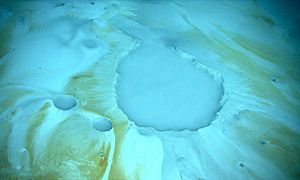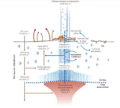Cold seep facts for kids
A cold seep (also called a cold vent) is a special place on the ocean floor. Here, liquids rich in chemicals like hydrogen sulfide, methane, and other hydrocarbons slowly leak out of the Earth's crust. Sometimes, these leaks form salty brine pools. Cold seeps create a unique biome (a community of living things) that supports many species found only there.
Over time, cold seeps can change the shape of the ocean floor. When methane reacts with seawater, it can create carbonate rock formations and even reefs. Tiny living things called bacteria can also affect these changes.
What Kinds of Cold Seeps Are There?
Cold seeps can have different names depending on how deep they are or what leaks out. Some common types include:
- Oil and gas seeps: These are places where oil or natural gas leaks out.
- Methane seeps: These are specific gas seeps where mostly methane leaks out.
- Gas hydrate seeps: Here, frozen methane gas (called gas hydrate) comes out.
- Brine seeps: These form very salty brine pools on the seafloor.
- Pockmarks: These are crater-like dents on the seafloor caused by fluids escaping.
- Mud volcanoes: These are mounds on the seafloor that release mud and fluids.
How Do Cold Seeps Form?
Cold seeps happen over cracks in the ocean floor. These cracks are caused by the slow movement of the Earth's huge plates. Oil and methane "seep" (slowly leak) out of these cracks. They mix with tiny bits of rock and spread out over an area that can be hundreds of meters wide.
Methane (CH4) is the main part of what we call natural gas. It's a big energy source for humans. But methane is also super important for the life that lives around cold seeps. It forms the basic food source for a whole ecosystem there!
Images for kids
-
Bacterial mat made of bacteria that use sulfide, found at a seep off South Carolina. The red dots are laser beams used for measuring.
-
Lamellibrachia tube worms and mussels at a cold seep. -
The Monterey Bay Aquarium Research Institute used the remotely operated underwater vehicle Ventana to study cold seeps.
-
A cold seep deposit from the Late Cretaceous period, found in South Dakota.
See also
 In Spanish: Emanación fría para niños
In Spanish: Emanación fría para niños














